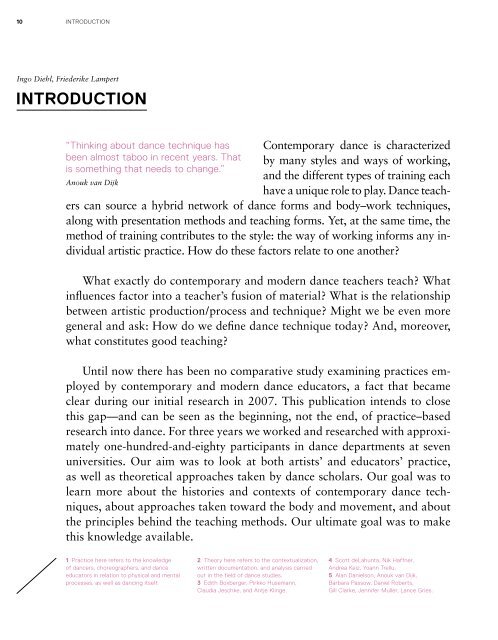Dance Techniques 2010
What does today's contemporary dance training look like? Seven research teams at well known European dance universities have tackled this question by working with and querying some of contemporary dance s most important teachers: Alan Danielson, Humphrey/Limón Tradition, Anouk van Dijk, Countertechnique, Barbara Passow, Jooss Leeder Technique, Daniel Roberts Cunningham Technique, Gill Clarke Minding Motion, Jennifer Muller Muller Technique, Lance Gries Release and Alignment Oriented Techniques. This comprehensive study includes interviews, scholarly contributions, and supplementary essays, as well as video recordings and lesson plans. It provides a comparative look into historical contexts, movement characteristics, concepts, and teaching methods. A workbook with two training DVDs for anyone involved in dance practice and theory. Ingo Diehl, Friederike Lampert (Eds.), Dance Techniques 2010 – Tanzplan Germany. With two DVDs. Berlin: Henschel 2011. ISBN 978-3-89487-689-0 (Englisch) Out of print.
What does today's contemporary dance training look like? Seven research teams at well known European dance universities have tackled this question by working with and querying some of contemporary dance s most important teachers: Alan Danielson, Humphrey/Limón Tradition, Anouk van Dijk, Countertechnique, Barbara Passow, Jooss Leeder Technique, Daniel Roberts Cunningham Technique, Gill Clarke Minding Motion, Jennifer Muller Muller Technique, Lance Gries Release and Alignment Oriented Techniques.
This comprehensive study includes interviews, scholarly contributions, and supplementary essays, as well as video recordings and lesson plans. It provides a comparative look into historical contexts, movement characteristics, concepts, and teaching methods. A workbook with two training DVDs for anyone involved in dance practice and theory.
Ingo Diehl, Friederike Lampert (Eds.), Dance Techniques 2010 – Tanzplan Germany. With two DVDs. Berlin: Henschel 2011. ISBN 978-3-89487-689-0 (Englisch) Out of print.
You also want an ePaper? Increase the reach of your titles
YUMPU automatically turns print PDFs into web optimized ePapers that Google loves.
10 Introduction<br />
Ingo Diehl, Friederike Lampert<br />
Introduction<br />
“Thinking about dance technique has<br />
been almost taboo in recent years. That<br />
is something that needs to change.”<br />
Anouk van Dijk<br />
Contemporary dance is characterized<br />
by many styles and ways of working,<br />
and the different types of training each<br />
have a unique role to play. <strong>Dance</strong> teachers<br />
can source a hybrid network of dance forms and body–work techniques,<br />
along with presentation methods and teaching forms. Yet, at the same time, the<br />
method of training contributes to the style: the way of working informs any individual<br />
artistic practice. How do these factors relate to one another?<br />
What exactly do contemporary and modern dance teachers teach? What<br />
influences factor into a teacher’s fusion of material? What is the relationship<br />
between artistic production / process and technique? Might we be even more<br />
general and ask: How do we define dance technique today? And, moreover,<br />
what constitutes good teaching?<br />
Until now there has been no comparative study examining practices employed<br />
by contemporary and modern dance educators, a fact that became<br />
clear during our initial research in 2007. This publication intends to close<br />
this gap—and can be seen as the beginning, not the end, of practice–based<br />
research into dance. For three years we worked and researched with approximately<br />
one-hundred-and-eighty participants in dance departments at seven<br />
universities. Our aim was to look at both artists’ and educators’ practice,<br />
as well as theoretical approaches taken by dance scholars. Our goal was to<br />
learn more about the histories and contexts of contemporary dance techniques,<br />
about approaches taken toward the body and movement, and about<br />
the principles behind the teaching methods. Our ultimate goal was to make<br />
this knowledge available.<br />
1 Practice here refers to the knowledge<br />
of dancers, choreographers, and dance<br />
educators in relation to physical and mental<br />
processes, as well as dancing itself.<br />
2 Theory here refers to the contextualization,<br />
written documentation, and analysis carried<br />
out in the field of dance studies.<br />
3 Edith Boxberger, Pirkko Husemann,<br />
Claudia Jeschke, and Antje Klinge.<br />
4 Scott deLahunta, Nik Haffner,<br />
Andrea Keiz, Yoann Trellu.<br />
5 Alan Danielson, Anouk van Dijk,<br />
Barbara Passow, Daniel Roberts,<br />
Gill Clarke, Jennifer Muller, Lance Gries.


















